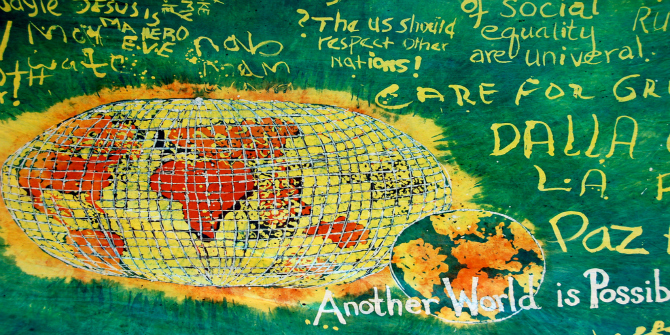In Globalization, Culture and Development: The UNESCO Convention on Cultural Diversity, editors Christiaan De Beukelaer, Miikka Pyykkönen and J. P. Singh present a series of research essays examining the 2005 UN Convention on the Protection and Promotion of the Diversity of Cultural Expressions. Jonathan Vickery argues that this volume not only critically explores one of the fastest conventions to have passed through the UN General Assembly, but also that its findings serve to shed further light on some of the broader problems bound up in the UN’s current role in global development.
Globalization, Culture and Development: The UNESCO Convention on Cultural Diversity. Christiaan De Beukelaer, Miikka Pyykkönen and J. P. Singh (eds). Palgrave Macmillan. 2015.
 This is an unusual, but important, set of research essays. Most people will have heard of the Convention on the Prevention and Punishment of the Crime of Genocide (1948) or the International Convention on the Elimination of All Forms of Racial Discrimination (1965) – but the Convention on the ‘Diversity of Cultural Expressions’? Perhaps this is because it is only ten years old, or perhaps because an international legal instrument for cultural policy would never make much of an impact. It was purported to be the ‘fastest’ convention to have passed through the UN General Assembly – was this evidence of global consensus or indifference?
This is an unusual, but important, set of research essays. Most people will have heard of the Convention on the Prevention and Punishment of the Crime of Genocide (1948) or the International Convention on the Elimination of All Forms of Racial Discrimination (1965) – but the Convention on the ‘Diversity of Cultural Expressions’? Perhaps this is because it is only ten years old, or perhaps because an international legal instrument for cultural policy would never make much of an impact. It was purported to be the ‘fastest’ convention to have passed through the UN General Assembly – was this evidence of global consensus or indifference?
The 2005 UN Convention on the Protection and Promotion of the Diversity of Cultural Expressions is not simply about ‘cultural diversity’ (now a longstanding political buzzword). Originally inspired by ‘biodiversity’, ‘diversity of cultural expressions’ is more expansive and includes relations between the production, distribution and consumption of culture, as well as the identity-based historical cultures of indigenous groups or minorities. In other words, as Raj Isar and Miikka Pyykkönen explain in the opening chapter, its range of application extends from heritage, custom, tradition and the ‘way of life’ culture that we associate with the socio-anthropological life of social groups (from nation states to small endangered tribes) to contemporary arts and the creative industries. Moreover, as attested to by the range of essays, culture is not a hermetic subject so much as a dynamic dimension of economy, history, society, human and gender rights, freedom of speech and expression, education and access to knowledge, as well as a host of other things. In fact, understanding the 2005 Convention is a good way of locating some of the intractable problems for the UN’s current role in global development per se.
With eighteen, predominantly European contributors, this volume has four sections on culture, diversity, the Convention itself and future developments (for example, roles for civil society and new ‘sustainable development’ frameworks). It assesses how the Convention has remained adequate to changing times (and yes, times have changed even in 10 years – think of digital media, and then read the chapter by Véronique Guèvremont). Moreover, as several chapters in the volume indicate, the context for the debates in the 1990s on culture and democracy, which initially motivated the Convention’s emergence, was formed in large part by GATT (General Agreement on Tariffs and Trade) and the WTO (World Trade Organisation) among others, quickly consolidating patterns of market behaviours we now refer to as global neoliberalism. In this light, the Convention is a critical document, defending culture against the onslaught of capitalism; yet, as contributor John Clammer expertly explains – quoting the Convention – it is less a document of resistance than accommodation. Here lies its complexity as it:
[…] lacks a hard edged analysis or concrete policy proposals of how to address the very issues that it itself raises, and in particular the ‘risks of imbalances’ between nations represented by globalization, and the need to take measures not only to affirm, but to actually protect in ‘situations where cultural expressions may be threatened by the possibility of extinction or serious impairment’.
In reality, however, while indigenous cultures and languages, like so many rainforests, have died out or been effectively killed off, the Convention does not convey much of an adequate understanding of ‘serious impairment’, which, one could argue, is much more pervasive and affects all culture. Consider, for example, the impact of imported entertainment on indigenous cultural life, the repressive impact of religious revival or, in an international development context, the ‘damage’ to indigenous cultural life from imposed modern Western education systems (indeed, culture’s biggest enemy is often other cultural expressions). An assumption of the Western critical tradition since Karl Marx is that all of modern culture is deformed by capitalism and inherently damaged (see, for example, the sub-title of Theodor Adorno’s 1951 book Minima Moralia: ‘Reflections on Damaged Life’). Modernity itself is the pulverisation of inherited community and culture.
 Image Credit: May 2009 – Cultural Diversity Week at UNESCO Headquarters in Paris – Shaolin Monks (China) (Wikipedia Public Domain)
Image Credit: May 2009 – Cultural Diversity Week at UNESCO Headquarters in Paris – Shaolin Monks (China) (Wikipedia Public Domain)
Here, for me, lies the central contradiction animating the 2005 Convention: in articulating the general normative conditions for the ‘protection and preservation’ of culture globally, it can – and arguably does, when translated into place-based cultural policies – underwrite political ideologies that actively oppose the very post-Enlightenment democratic political philosophy that inspired it. In other words, it can be used to legitimise and bolster current patriarchal, traditional, customary, superstitious or religious ‘culture’, because this also is the valued ‘culture’ that is expressive of a coherent group of adherents or peoples, and the product of historical circumstances.
This volume nonetheless does well to insist on at least two major caveats to this view. Firstly, the Convention is shot through with linguistic references to other conventions (human rights and social equality particularly, but also intellectual property); and secondly, the Convention in practice doesn’t work this way. As Helmut Anheier and Michael Hoelscher’s chapter reports, the Convention has effectively supported the legitimisation of important civil society actors in the cultural sphere, even if this is more substantial in the Global North than in the South.
In fact, it is difficult not to have a positive regard for the Convention considering the amount of work (research, pan-national negotiations, political lobbying) that devising a UN Convention demands. It is easy to ignore the institutional framework of conventions: in this case, the International Fund for Cultural Diversity, The Conference of Parties and biennial reports on implementation from member states, The Intergovernmental Committee, all of which are meant to ‘police’ and evaluate member state progress in implementing the Convention. This volume does not rigorously evaluate the Convention in this regard – how could it? It does, however, succeed in exegeting its democracy dimension, where (it is hoped) that the Convention’s implementation is itself a process of democratisation: in this case, an application of the broader pluralist ethics of the UN system.
And it is on ‘pluralism’ that I wish to end. A key dimension of the 2005 Convention is its understanding of the problematic nature of implementation, requiring the above institutional framework and a balance of powers between nation state governments, civil society organisations and social groups (including independently represented peoples, or even arts or cultural organisations). The Convention’s thirty-five Articles, reproduced at the back of the volume, are not just a general expression of a good-will ‘live and let live’ attitude to everyone’s way of life, but rather articulate the real demands of an international democratic governance of culture – even though, in fact, it does not set out how cultural government could actually work (it is hard to see how many of the non-democratic members of the UN Assembly could ever implement many of its Articles). The Convention is ‘pluralist’ without saying it, for it emerged from the inspirational UNESCO Declaration of 2001, which itself emerged from a discourse represented by the equally inspiring 1999 report, Towards a Constructive Pluralism (UNESCO, 1999), and the slightly earlier UNESCO Report of the World Commission on Culture and Development, Our Creative Diversity (1996), as well as concomitant United Nations Development Programme (UNDP) Human Development reports. Articulated properly, pluralism as a concept (avoided in the final wording of the 2005 Convention) obviates the problems of multiculturalism, while motivating new models of global civil society. Given current affairs and global conflict, the task of defining a culturally pluralist civil society is surely an urgent one.
Dr. Jonathan Vickery is an Associate Professor in Warwick University’s Centre for Cultural Policy Studies. He is Director of the Masters program in Arts, Enterprise and Development, and is currently involved in research projects on global cultural policies, the impacts of European cultural industries and creative industries in Shanghai. Read more reviews by Jonathan Vickery.
Note: This review gives the views of the author, and not the position of the LSE Review of Books blog, or of the London School of Economics.







